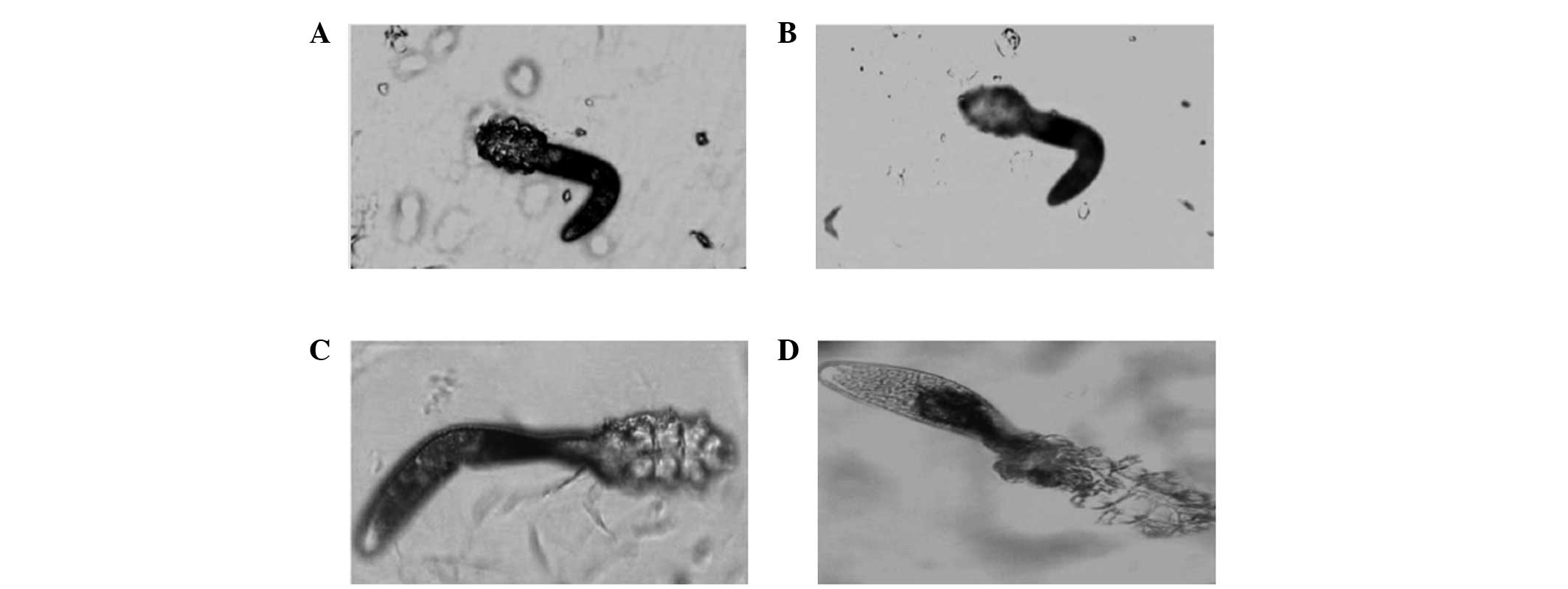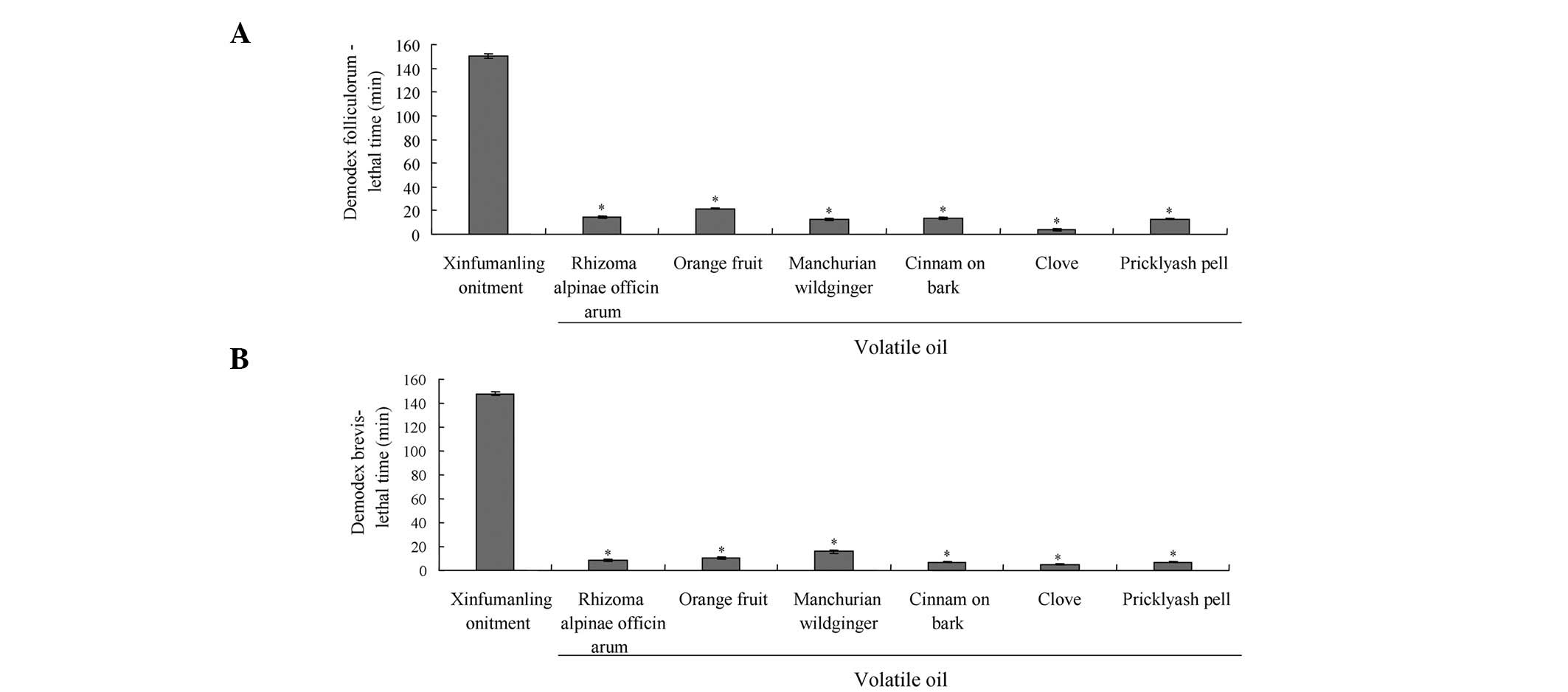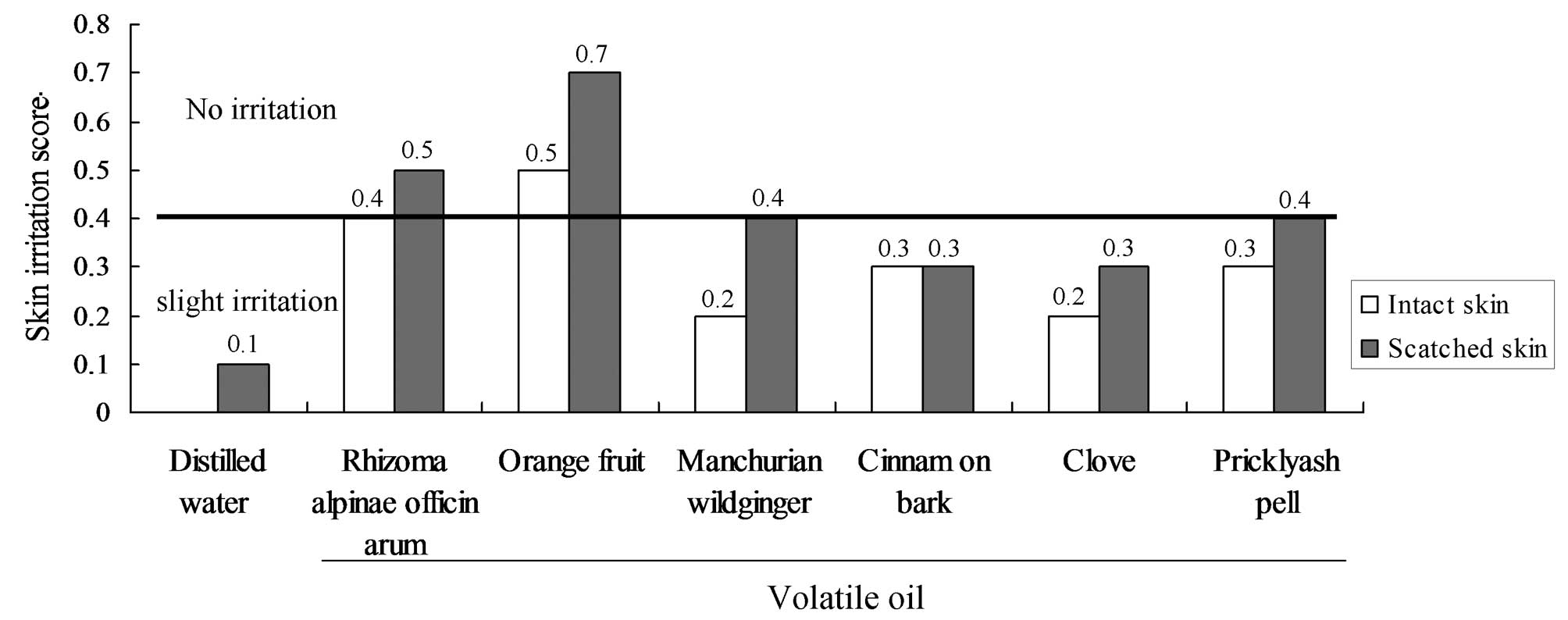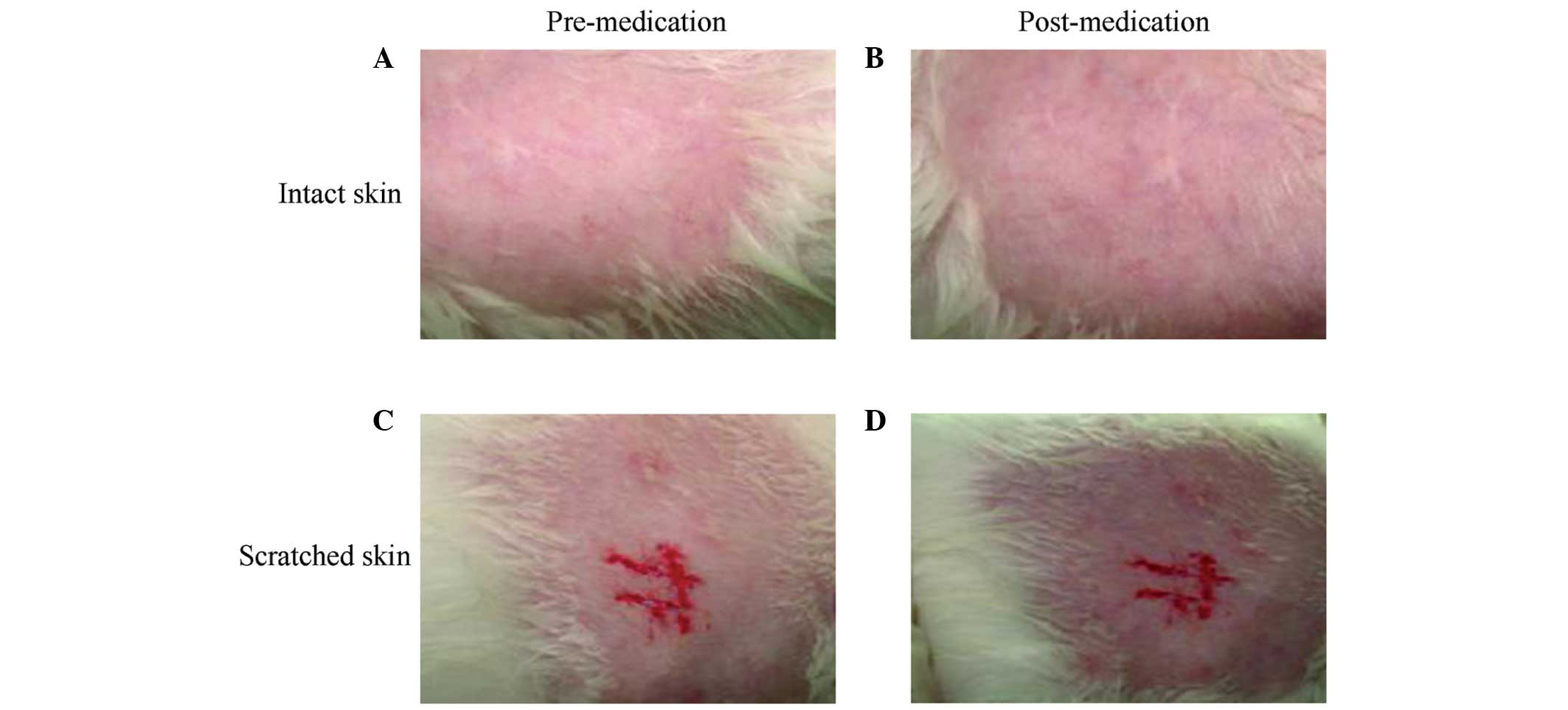Introduction
Demodex, a type of permanent obligatory
parasite (class, Arachnida; superorder, Acariformes), is an
elongated ectoparasite found on the human body surface, including
the face, cheeks, forehead, nose and eyelids (1). There are numerous species of
Demodex, but only Demodex folliculorum and Demodex
brevis are found on the human body (2,3). The
organism, Demodex folliculorum, is found in the eyelash
follicle, while Demodex brevis burrows deep into the
sebaceous and meibomian glands (3). The rate of Demodex infestation
increases with age, with the organism identified in 84% of the
population at age 60 and in 100% of those aged >70 years
(4). In addition to the higher
density of Demodex observed in patients with rosacea
(5), Demodex has also been
suggested as a cause of other skin diseases, including pityriasis
folliculorum, perioral dermatitis (6,7),
scabies-like eruptions, facial pigmentation, eruptions of the bald
scalp, demodicosis gravis and even basal cell carcinoma (8,9).
Although the pathogenic role remains elusive, efforts have been
made to eradicate ocular Demodex in patients presenting with
blepharitis (10).
To date, a number of studies (6,7,10)
have investigated various drugs targeting Demodex; however,
the majority of these drugs were not found to be effective. There
are seldom studies investigating the antiparasitic effects of
volatile oils from Chinese crude drugs against Demodex.
Thus, the present study selected six types of Chinese crude drugs,
among the 300 drugs that are rich in volatile oil. Subsequently,
the anti-Demodex efficacy and safety were studied for the
six volatile oils used in the Demodex therapy.
Materials and methods
Materials, reagents and animals
Clove, orange fruit, Manchurian wild ginger,
cinnamon bark, Rhizoma Alpiniae Officinarum and pricklyash peel
were purchased from Huainan Hengkang Medicine Co., Ltd. (Huainan,
China). The quality of these drugs was assessed by Professor Genbao
Zhang in the Department of Pharmacy (Qiqihar Medical University,
Qiqihar, China). An optical microscope and photographic system were
purchased from Nikon Corporation (model SMZ1500, Tokyo, Japan). The
clinical anti-Demodex drug, Xin Fumanling ointment, was
purchased from Shandong Jiankang Pharmaceutical Co., Ltd. (Jinan,
China). In total, four male rabbits and four female rabbits
(weight, 2.0–2.5 kg) were provided by the Experimental Animal Base
of Anhui University of Science and Technology (Huainan, China). The
eight rabbits were divided into two groups randomly; one group
received treatment with the volatile oils, while the other group
received Xin Fumanling ointment treatment. Furthermore, sodium
chloride solution was selected as the negative control. The present
study was approved by the Ethics Committee of Qiqihar Medical
University.
Extraction of volatile oil
In total, 50-g samples of each Chinese crude
medicine were smashed, filtered and soaked for 8 h. The extraction
of volatile oil was performed using a distillation method, followed
by drying with sodium sulfate. The detailed procedures were
performed according to previous studies (11,12).
In vitro experiment
Since there is a high prevalence of Demodex
in patients with cylindrical dandruff, lashes with cylindrical
dandruff were selected for the in vitro experiment (13). A total of 20 patients were selected
to obtain the Demodex, these patients were diagnosed by the
Department of Dermatology (Qiqihar Medical University). Informed
consent was obtained from all of the patients. Demodex was
obtained with cellulose tape at room temperature (30±0.5°C). The
experiment was performed in a good manufacturing practice
laboratory. Volatile oil was dripped onto the Demodex with a
micropipette, and the movements of the Demodex body and legs
were observed continuously under a microscope (CX31; Olympus,
Tokyo, Japan) at ×40 magnification for 60 min. Death of the
parasite was defined as no movements of the body and no changes to
the legs for a minimum of 30 sec. The lethal time was defined as
the time between the addition of the solution and when the organism
stopped moving. Xin Fumanling ointment was used as the positive
control, while saline served as the blank control.
Skin irritation test
In total, a 0.3-μl sample of each volatile oil was
applied to a section of the rabbit skin with the size of 2.5×2.5
cm. The skin was fixed with the bandage. Exposure time to the
volatile oil lasted for 24 h, after which fresh saline was applied
to the same site for clearing of the retained volatile oils.
Measurements of skin irritation
Assessments of skin irritation were performed
according to two criteria (14).
The first criteria was scored as follows: No erythema, 0 points;
speckling, moderate erythema, 1 point; uniform, moderate erythema,
2 points; intense erythema, 3 points; and intense erythema (red
hot) with edema, 4 points. The second criteria was scored as
follows: No edema, 0 points, extremely slight edema, 1 point;
slight edema, 2 points; moderate edema, 3 points; and serious
edema, 4 points. The skin irritation score was evaluated by
combining the two criteria. No irritation was defined as 0.0–0.4
points, slight irritation was classified as 0.5–1.9 points,
moderate irritation was defined as 2.0–5.9 points and intense
irritation was classified as 6.0–8.0 points.
Acute toxicity test
Acute toxicity of the volatile oils was investigated
using the rabbits treated with Demodex. Observations of the
rabbits were conducted for one week continuously. The aim of this
experiment was to observe the systemic toxicity and mortality of
the rabbits, including changes to the skin, hair, eyes and mucosa,
changes to the respiratory system, circulatory system and central
nervous system, limbs activities and behavioral style. In
particular, observations of a tremble and muzziness were recorded.
The criteria used for assessing acute toxicity was performed
according to previous studies (15,16).
Statistical analysis
Data are expressed as the mean ± standard deviation,
and were analyzed using Microsoft Excel (Microsoft, Redmont, WA,
USA). The data between groups were evaluated using a two-tailed
t-test, where P<0.05 was considered to indicate a statistically
significant difference.
Results
Antiparasitic activity of the volatile
oils
Sodium chloride was used as a negative control and
was shown to have no effects on the rabbits (data not shown). Prior
to the addition of the volatile oils, the two species of
Demodex were active, with the limbs maintaining an exercise
status (Fig. 1). The average
exercise frequency of each limb was >15 times/min. Following
addition of the volatile oils, the polypides exercised intensively
and contracted, deforming significantly (Fig. 1). The exercise frequency
significantly increased to >20 times/min. The Demodex
polypide was exercising in the volatile oils, experiencing a
shortly excited state, which indicated an inhibitory state.
Finally, the activity of Demodex decreased significantly,
and a parasiticide outcome was achieved.
Lethal times of the volatile oils on
Demodex
All six types of volatile oils were shown to kill
the two species of Demodex within 30 min. All the volatile
oils demonstrated a significantly higher antiparasitic activity
compared with the positive control of Xin Fumanling ointment
(Fig. 2; P<0.05). In addition,
the antiparasitic activity of the volatile oil from Manchurian wild
ginger and clove on Demodex folliculorum were significantly
higher compared with that on Demodex brevis (Fig. 2; P<0.05).
Volatile oils trigger no significant skin
irritation
Results from the skin irritation test indicated that
Rhizoma Alpiniae Officinarum and orange fruit induced only a slight
irritation. Furthermore, Manchurian wild ginger, cinnamon bark,
clove and pricklyash peel were not shown to induce any irritation
for the intact skin or scratched skin, with scores of <0.4
points (Fig. 3). In particular,
the clove volatile oil was not found to trigger any irritation,
with effects equivalent to those of distilled water.
No significant adverse effects were
observed with the volatile oil-treated skin
After one week of observation, no adverse effects
were observed on the intact skin and scratched skin of the rabbits.
The weight, hair, skin, respiratory system and limb activity of the
rabbits were not shown to exhibit a significant abnormality
(Fig. 4).
Discussion
A number of drugs have been applied as
anti-Demodex therapy, including 1–2% metronidazole (17), 2 or 5% permethrin (18), 200 g/kg ivermectin (19), amongst others. However, the
aforementioned drugs require complex synthetic technology, and have
been shown to exert certain adverse effects following application.
Chinese medicine shares the benefits of reduced side effects, minor
toxicity and few side effects; thus, may play an important role in
anti-Demodex therapy. To date, a number of Chinese drugs
have been synthesized for Demodex therapy in China.
Volatile oil is a type of oily liquid with
characteristics of extensive bioactivity and an aromatic odor
(20). The present study selected
six types of volatile oils, extracted using a distillation method,
and observed their anti-Demodex activity. The results
indicated that all the volatile oils possessed more intense
anti-Demodex activity compared with the positive control.
Among these volatile oils, the clove volatile oil provided the most
intense anti-Demodex activity.
A previous study (21) also investigated the effects of
clove, orange fruit, Manchurian wildginger, cinnamon bark, Rhizome
Alpiniae Officinarum and pricklyash peel. However, the
anti-Demodex function has not yet been fully explored. In
the present study, clove volatile oil was adopted as the
therapeutic drug, which was shown to trigger significant
anti-Demodex activity compared with the Xin Fumanling
ointment. According to the criteria outlined by the National Health
and Family Planning Commission of China (Beijing, China), all
maquillage and drugs designed for the skin should not cause mucosal
irritation and damage. In the present study, a skin irritation test
was performed to identify the safety of the volatile oils. From the
irritation test results, it was found that no erythema or edema
were observed in the intact skin, and only slight erythema was
observed in the scratched skin following the application of clove
volatile oil. An acute toxicity test was applied to analyze the
toxicity and adverse effects. The results revealed that the clove
volatile oil did not exhibit acute toxicity on the rabbit skin.
Clove resources are very rich, and the volatile oil can be
extracted conveniently. The low toxicity and safety demonstrate the
feasibility of using clove volatile oil in clinical and basic
studies.
In conclusion, Chinese crude medicine volatile oil,
particularly that for clove, demonstrated a marked
anti-Demodex activity. The clove volatile oil was shown to
kill Demodex effectively and safely in vivo.
Acknowledgements
The study was supported by a grant from the Science
and Technology Program from the Department of Education,
Heilongjiang Province (no. 12521628).
References
|
1
|
Baima B and Sticherling M: Demodicidosis
revisited. Acta Derm Venereol. 82:3–6. 2002. View Article : Google Scholar : PubMed/NCBI
|
|
2
|
Kim JH, Chun YS and Kim JC: Clinical and
immunological responses in ocular demodecosis. J Korean Med Sci.
26:1231–1237. 2011. View Article : Google Scholar : PubMed/NCBI
|
|
3
|
English FP and Nutting WB: Demodicosis of
ophthalmic concern. Am J Ophthalmol. 91:362–372. 1981. View Article : Google Scholar : PubMed/NCBI
|
|
4
|
Liu J, Sheha H and Tseng SC: Pathogenic
role of Demodex mites in blepharitis. Curr Opin Allergy Clin
Immunol. 10:505–510. 2010. View Article : Google Scholar : PubMed/NCBI
|
|
5
|
Forton F, Germaux MA, Brasseur T, De
Liever A, Laporte M, Mathys C, Sass U, Stene JJ, Thibaut S, Tytgat
M and Seys B: Demodicosis and rosacea: epidemiology and
significance in daily dermatologic practice. J Am Acad Dermatol.
52:74–87. 2005. View Article : Google Scholar : PubMed/NCBI
|
|
6
|
Yang G, Geng C, Li Y, Liu A and Chen W:
Multiple myeloma with extramedullary plasmacytoma invading the skin
and eyeballs following autologous stem cell transplantation: A case
report. Exp Ther Med. 6:883–886. 2013.PubMed/NCBI
|
|
7
|
Morrás PG, Santos SP, Imedio IL,
Echeverría ML and Hermosa JM: Rosacea-like demodicidosis in an
immunocompromised child. Pediatr Dermatol. 20:28–30. 2003.
View Article : Google Scholar : PubMed/NCBI
|
|
8
|
Erbagci Z, Erbagci I and Erkiliç S: High
incidence of demodicidosis in eyelid basal cell carcinomas. Int J
Dermatol. 42:567–571. 2003. View Article : Google Scholar : PubMed/NCBI
|
|
9
|
Zhao GJ, Hong GL, Liu JQ, Lu Y and Lu ZQ:
Septic shock due to community-acquired Pseudomonas aeruginosa
necrotizing fasciitis: A case report and literature review. Exp
Ther Med. 7:1545–1548. 2014.PubMed/NCBI
|
|
10
|
Gao YY, Di Pascuale MA, Li W,
Baradaran-Rafii A, Elizondo A, Kuo CL, Raju VK and Tseng SC: In
vitro and in vivo killing of ocular Demodex by tea tree oil. Br J
Ophthalmol. 89:1468–1473. 2005. View Article : Google Scholar : PubMed/NCBI
|
|
11
|
Coelho JP, Cristino AF, Matos PG, Rauter
AP, Nobre BP, Mendes RL, Barroso JG, Mainar A, Uriteta JS,
Fareleira JM, Sovová H and Palavra AF: Extraction of volatile oil
from aromatic plants with supercritical carbon dioxide: experiments
and modeling. Molecules. 17:10550–10573. 2012. View Article : Google Scholar : PubMed/NCBI
|
|
12
|
Hu M, Zhang H, Feng B, Liu K and Guo S:
Extraction of polysaccharides from Fomes officinalis Ames and their
antitumor activity. Exp Ther Med. 6:451–454. 2013.PubMed/NCBI
|
|
13
|
Gao YY, Di Pascuale M, Li W, et al: High
prevalence of Demodex in eye lashes with cylindrical dandruff.
Invest Ophthalmol Vis Sci. 46:3089–3094. 2005. View Article : Google Scholar : PubMed/NCBI
|
|
14
|
Baranda L, González-Amaro R,
Torres-Alvarez B, Alvarez C and Ramírez V: Correlation between pH
and irritant effect of cleansers marketed for dry skin. Int J
Dermatol. 41:494–499. 2002. View Article : Google Scholar : PubMed/NCBI
|
|
15
|
Yamamoto K, Igawa K, Sugimoto K, Yoshizawa
Y, Yanagiguchi K, Ikeda T, Yamada S and Hayashi Y: Biological
safety of fish (tilapia) collagen. Biomed Res Int. 2014:6307572014.
View Article : Google Scholar : PubMed/NCBI
|
|
16
|
Lee SH: Evaluation of acute skin
irritation and phototoxicity by aqueous and ethanol fractions of
Angelica keiskei. Exp Ther Med. 5:45–50. 2013.
|
|
17
|
Koçak M, Yaǧli S, Vahapoǧlu G and Ekşioǧlu
M: Permethrin 5% cream versus metronidazole 0.75% gel for the
treatment of papulopustular rosacea. A randomized double-blind
placebo-controlled study. Dermatology. 205:265–270. 2002.
View Article : Google Scholar
|
|
18
|
Forstinger C, Kittler H and Binder M:
Treatment of rosacea-like demodicidosis with oral ivermectin and
topical permethrin cream. J Am Acad Dermatol. 41:775–777. 1999.
View Article : Google Scholar : PubMed/NCBI
|
|
19
|
Persi A and Rebora A: Metronidazole and
Demodex folliculorum. Acta Derm Venereol. 61:182–183.
1981.PubMed/NCBI
|
|
20
|
Liu X, Meng Q, Song H and Zhao T: A
traditional Chinese herbal formula improves pressure ulcers in
paraplegic patients: A randomized, parallel-group, retrospective
trial. Exp Ther Med. 5:1693–1696. 2013.PubMed/NCBI
|
|
21
|
Liu JX, Li CP, Zhang H and Sun YH:
Volatile oil of Chinese crude drug against human Demodex:
effectiveness and safety. Di 2 Jun Yi Da Xue Xue Bao. 29:1048–1051.
2009.(In Chinese).
|


















